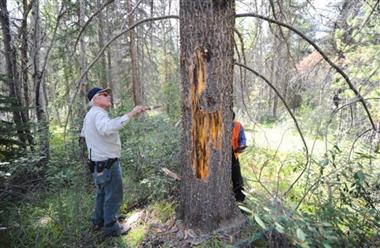Parks Canada is reporting that mountain pine beetle populations have practically bottomed out in Jasper National Park.

The most recent population survey shows that their numbers have dropped 94 per cent since their most recent peak in 2019.
The survey also shows a sharp decline in trees killed by mountain pine beetle for the fourth consecutive year.
Dave Argument, resource conservation officer with Parks Canada, said that he expected to see a continued decline in the mountain pine beetle.
“This year’s survey results are not a surprise to us. They’re confirmation of the good news story that we’ve been seeing.”
It was the memorable cold snap of the winter of 2019 that really started to significantly bring down the population of mountain pine beetles.
Parks Canada has been conducting two surveys on the situation every year, the first of which is the overwintering larva survival survey, otherwise called the R-value survey.

It takes place in the spring when surveyors can peel off a piece of bark in a test area so they can count the larvae, both living and the dead, underneath.
If they find no living larvae, they will then dig into the base of the tree, which would have been covered by an insulating blanket of snow during the winter.
That’s where the beetle larvae would have a better chance of surviving even the bitterest cold.
“It’s probably been in the last three winters where we’ve had really good winter conditions that have killed those overwintering larvae to the point where now, this year’s survey — no larvae found whatsoever. Not a single living larva was found,” Argument said.
“There’s effectively no growth.”
Later in the year, Parks conducts an aerial survey over a broader section of Jasper National Park. It offers an unparalleled viewpoint for the visible signs of those red trees on the landscape as a way of detecting previously undiscovered pockets of infestation.
That survey also aids in mapping out the total area impacted by the mountain pine beetle.
In 2019, the aerial survey showed a 30 per cent increase in area over the previous year, totaling approximately 230,000 hectares.
This year’s aerial survey was completed in August and covered 6.88 million hectares. The final report came in showing only 95.2 hectares with fading foliage, the telltale sign of a mountain pine beetle-infested tree.
“That’s an incredibly small area relative to the big picture of the park. Some of that may be an effect of other types of forest insects — bark beetles and wood-boring beetles — that have killed already weakened trees. But to say only 95 hectares this year of impacted trees — that basically means a beetle is done. It’s collapsed. And it’s gone,” Argument said.
“That’s really good news. They are done in Jasper for the time being, which we’re, of course, very pleased with.”
More than 2.4 million hectares of forest across Alberta have been affected by the spread of mountain pine beetle. Nearly all of the pine trees have been killed in the most severely affected areas.

The threat of resurgence still remains in some areas including the Bow Valley, Kananaskis, and Crowsnest Pass.
For those regions, Alberta’s mountain pine beetle management plan is moving into its next phase. It means partnering with local and Indigenous contractors to control beetle activities with targeted, single-tree cutting and burning, as well as whole-tree chipping and harvesting entire areas of affected pine trees as needed.
Ground operations are already underway to manage those sites.
Last year, the average number of infested trees per site fell to approximately three. This is the lowest level reported since the province’s management program began. It’s a far cry from the all-time high of more than 18 per site back in 2009.

This is especially welcome news to Todd Loewen, Minister of Forestry, Parks and Tourism. A news release issued last week noted that Alberta has 5.5 million hectares of pine trees that are susceptible to the mountain pine beetle. The value of this pine is more than $11 billion, the release states.
“I am pleased to see that our approach to controlling the spread of mountain pine beetles and favourable weather trends are having such a positive impact in many areas around the province, and we will continue to protect our forests for future generations,” Loewen said.




Comments